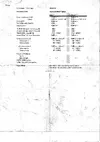JGM
Member
Hello everyone,
First thank you Mark Davis for inviting me to come here.
I have a 87 Red GT Turbo. After some 6 years gathering parts, it underwent a almost total rebuilt some 3 years ago.
Andybond, happy to oblige with the photos barrage...
Disassembly :
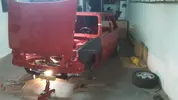
After paint:

Engine assembly:
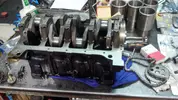


Took almost one of everything still available at the Renault dealer at the time
Engine bits:
- OEM Mahle Liners, Pistons and rings
- Mahle standard size crank shells
- Mahle standard size rod shells
- Washer on oil pump to increase pressure
- Corteco/Meillor Blue head gasket
- 12.9 steel head screws
- CatCams 270 in standard pulley.
- Piper "uprated" valve springs
- New valve stem seals
- Valve guides were deemed OK by the machine shop.
- K-Tec GroupA carb and 2 standard carbs.
- K-tec T25 turbo (230 was its name i think)
- Volvo 480 Sachs Clutch
- Renault 11 turbo gear box
- Mocal oil cooler with thermostat
- Copper Core radiator
- Double alloy intercooler
- Walbro fuel pump
- Malpassi fuel pressure regulator
- 2.5 " SS Scorpion exhaust with custom chambered muffler.
- New subframe
- Full Koni shocks
- Full new seat sub frames, cloth and foams
- All new doors, windshield, window rubbers and seals
This helped a lot, thanks Renault!!
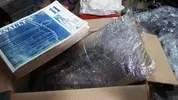
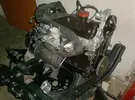
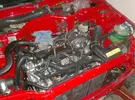

Finally at a local car gathering
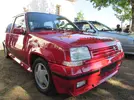
But it has problems and i need some help diagnosing, please!!!!
Since the very first run the engine demanded the GrpA carb mixture screw to be wound out around 8 to 10/5 turns from fully in.
The idle was steady(ish) but was very very weak, just turning head lights or the radiator fan cutting in would bring idle at the tach +-800rpm to 450/500 rpm.
I finally got hold of a set of two good standard carburetors but the car would only run, very rough, with the choke flap closed or if the mixture screw was around 12/13 turns from totally in. Cold start (ambient 23ºC), engine doesn't run bellow 1500rpm, rpms controlled inside the car with the choke mechanism.
Summary of 2 months testing done:
- Checked for vacuum leaks on manifold, carb, oil breather pipes, brake booster and master cylinder. Some found, corrected and double checked.
- Tested carbs, Re209 module, on two other R5 GTT and all was good, idle, no detonations on boost, AND misture screws at around 3/4 turns from fully wound in.
- Tested Re209 power supply, crank position sensor resistance and coil spark strength according to Renault manuals available online. All in spec.
- Tested with oem renault plugs, NGK BR8s and BR9s, all the same, gaped correctly.
- Pressure tested intake manifold with the one way valves still screwed in at 5bar+, then immersed in water and no leaks or cracks found.
- Intake manifold sent to machine shop to check and correct contact surfaces.
- Vacuum tested the brake booster and its hose. Held constant -0.9 bar vacuum for 2+ hours.
- Oil breather system has both restrictors in place, hoses and plastic T were pressure tested to 1.5 bar (21 PSI) with no leaks
- Malpassi adjustable fuel pressure regulator set to 4 psi(i think) at idle. Plenty of gas, "Believe Me!" like Trump says.
- Catcams assures cam should work fine without adjustable vernier pulley.
- Cold compression test with 142.5 psi all round, good i think?
- Tested valve lash/gaps from the std 0.15/0.2 to 0.25/0.25 to MAX catcams recommends 0.3/0.35 . No change.
My spark plugs are usually like this but afr are always way too lean.

Engine vacuum readings are difficult to pinpoint, needle fluctuates violently at idle between -5 to -9.5 PSI (converted from my -0.35 to -0.65 bar). Increasing rpms the needle settles at around 7.9psi.(0.55 bar). Reading taken with and without brake booster and oil breather systems attached to manifold. same problem.
In this site How to Use and Interpret a Vacuum Gauge you can see various scenarios and mine appears to similar to scenario 8, BUT the machine shop deemed the valve guides OK.
Need help checking if the timing is correct, I have searched for a Haynes manual but no luck.
Aligning the flywheel at the bell housing the dizzy points to either piston 1 or 4 every 360 degrees crank rotation, but how to be sure the cam is right?
Very very sorry for lengthy post.
First thank you Mark Davis for inviting me to come here.
I have a 87 Red GT Turbo. After some 6 years gathering parts, it underwent a almost total rebuilt some 3 years ago.
Andybond, happy to oblige with the photos barrage...
Disassembly :

After paint:

Engine assembly:



Took almost one of everything still available at the Renault dealer at the time
Engine bits:
- OEM Mahle Liners, Pistons and rings
- Mahle standard size crank shells
- Mahle standard size rod shells
- Washer on oil pump to increase pressure
- Corteco/Meillor Blue head gasket
- 12.9 steel head screws
- CatCams 270 in standard pulley.
- Piper "uprated" valve springs
- New valve stem seals
- Valve guides were deemed OK by the machine shop.
- K-Tec GroupA carb and 2 standard carbs.
- K-tec T25 turbo (230 was its name i think)
- Volvo 480 Sachs Clutch
- Renault 11 turbo gear box
- Mocal oil cooler with thermostat
- Copper Core radiator
- Double alloy intercooler
- Walbro fuel pump
- Malpassi fuel pressure regulator
- 2.5 " SS Scorpion exhaust with custom chambered muffler.
- New subframe
- Full Koni shocks
- Full new seat sub frames, cloth and foams
- All new doors, windshield, window rubbers and seals
This helped a lot, thanks Renault!!




Finally at a local car gathering

But it has problems and i need some help diagnosing, please!!!!
Since the very first run the engine demanded the GrpA carb mixture screw to be wound out around 8 to 10/5 turns from fully in.
The idle was steady(ish) but was very very weak, just turning head lights or the radiator fan cutting in would bring idle at the tach +-800rpm to 450/500 rpm.
I finally got hold of a set of two good standard carburetors but the car would only run, very rough, with the choke flap closed or if the mixture screw was around 12/13 turns from totally in. Cold start (ambient 23ºC), engine doesn't run bellow 1500rpm, rpms controlled inside the car with the choke mechanism.
Summary of 2 months testing done:
- Checked for vacuum leaks on manifold, carb, oil breather pipes, brake booster and master cylinder. Some found, corrected and double checked.
- Tested carbs, Re209 module, on two other R5 GTT and all was good, idle, no detonations on boost, AND misture screws at around 3/4 turns from fully wound in.
- Tested Re209 power supply, crank position sensor resistance and coil spark strength according to Renault manuals available online. All in spec.
- Tested with oem renault plugs, NGK BR8s and BR9s, all the same, gaped correctly.
- Pressure tested intake manifold with the one way valves still screwed in at 5bar+, then immersed in water and no leaks or cracks found.
- Intake manifold sent to machine shop to check and correct contact surfaces.
- Vacuum tested the brake booster and its hose. Held constant -0.9 bar vacuum for 2+ hours.
- Oil breather system has both restrictors in place, hoses and plastic T were pressure tested to 1.5 bar (21 PSI) with no leaks
- Malpassi adjustable fuel pressure regulator set to 4 psi(i think) at idle. Plenty of gas, "Believe Me!" like Trump says.
- Catcams assures cam should work fine without adjustable vernier pulley.
- Cold compression test with 142.5 psi all round, good i think?
- Tested valve lash/gaps from the std 0.15/0.2 to 0.25/0.25 to MAX catcams recommends 0.3/0.35 . No change.
My spark plugs are usually like this but afr are always way too lean.

Engine vacuum readings are difficult to pinpoint, needle fluctuates violently at idle between -5 to -9.5 PSI (converted from my -0.35 to -0.65 bar). Increasing rpms the needle settles at around 7.9psi.(0.55 bar). Reading taken with and without brake booster and oil breather systems attached to manifold. same problem.
In this site How to Use and Interpret a Vacuum Gauge you can see various scenarios and mine appears to similar to scenario 8, BUT the machine shop deemed the valve guides OK.
Need help checking if the timing is correct, I have searched for a Haynes manual but no luck.
Aligning the flywheel at the bell housing the dizzy points to either piston 1 or 4 every 360 degrees crank rotation, but how to be sure the cam is right?
Very very sorry for lengthy post.

